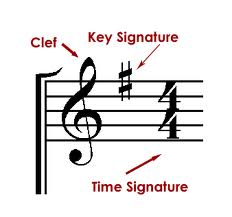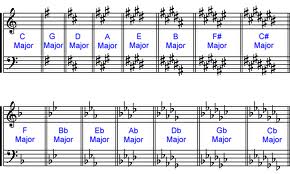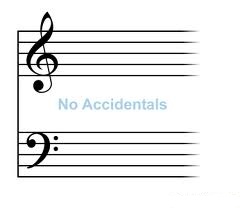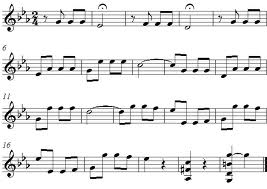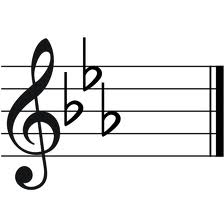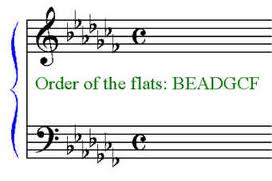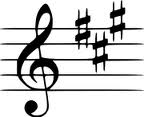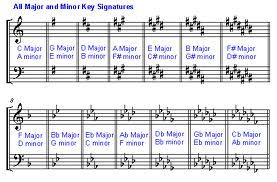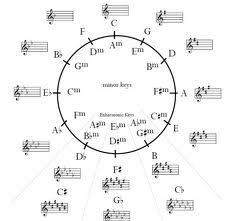Key Signatures
Key Signatures are defined by the accidentals that naturally occur in the Major Scale. When writing sheet music, it would become very cluttered to write a Flat or Sharp in front of every note that needed it, so a standard was set to write them at the beginning of every line or anyplace where the Key Signature changes. Below is a list of Key Signatures.
Once again, Key Signatures are defined by the accidentals that naturally occur in the Major Scale (or Minor Scale which we will address further in the lesson). To help you see this, let’s look at the C Major Scale. It consists of the following notes:
C D E F G A B C
There are no sharps or flats. Likewise, there are no sharps or flats in the Key of C (or Key of C Major).
If you recall in Lesson 7, we discussed the Major Scale. And now that you know the Major scale, you also know the Key Signature.
There are tricks to it and we will discuss that (since you already know what is in each Key Signature).
If you were to see a piece of sheet music, it would tell you the Key Signature at the beginning of the song (as seen below). This is the beginning of Beethoven’s 5th Symphony.
Notice the three (3) flats just after each Treble Clef. Now you know that this piece of music was written in three (3) flats or in the Key of Eb.
You are probably thinking, “Well how did you know it was Eb?” There is a trick to that as well. But before I can teach you that, you need to know how things occur. Flats (as well as Sharps) occur in a certain order every time. Examine this sequence of letters:
B E A D G C F
This is the order which Flats occur. If music is written in one flat, the one flat will be B; if music is written in two flats, those flats will be B and E; if music is written in three flats(like Beethoven’s 5th Symphony) , those flats will be B, E, and A; and so on. If you notice , the first four letters spell “BEAD”. That is how I remember it, and then I just memorized the G, C, and F. However, I have had students make up acronyms to help them remember. One such acronym is, “Busy Eaters And Drinkers Get Careless Fingers”. How you remember the letters is up to you.
The next step is to determine what Key the music is in, and the trick is, it is the next to the last flat. Let’s use Beethoven’s 5th Symphony as an example. It was written in three (3) Flats. Those Flats are “B”, “E”, and “A”. The next to the last Flat is “E”, so Eb is the key of the music. If the song had been written in four (4) Flats, those Flats would be “B”, “E”, “A”, and “D”. The next to the last Flat would be “A”, so Ab would be the Key of the music.
Now that you know that, Sharps also occur in a specific order. They are in the exact order of the Flats, but backwards. They occur as follows:
F C G D A E B
If the music was written in three (3) Sharps, those Sharps would be “F”, “C”, and “G”. And to determine what Key the music is in, It is one-half step above the last Sharp. With the last Sharp being “G”, one-half step above a G# is “A”. Thus, three (3) Sharps is the Key of “A”.
Minor Scales can be used as well. They are usually referenced as “Relative Minors” because of their relationship to the Major Scale. They are considered relatives because they share the same Key Signature. The Key of A minor has no Sharps or Flats and the key of C Major has no Sharps or Flats. “A” Minor is considered the “Relative Minor” of C.
Below is a list of Key Signatures and their Relative Minors.
Most of the time when the Key Signature changes in a song, they add or subtract a Sharp or Flat. And theoretically a song could include every Key Signature by adding or subtracting all the way through the list until you come back to the original Key. To do this, you would have to link them together. Well that’s been done for you already. It is called “The Circle of Fifths”. Below is this Circle of Fifths.
It is called the Circle of Fifths because each succession is the fifth note of the previous one.
An example is the key of “C”. It has no Sharps or Flats It progresses as C, D, E, F, G. G is the fifth note. G has one Sharp. G progresses as G, A, B, C, D. D is the fifth note. D has two Sharps. . D progresses as D, E, F#, G, A. A is the fifth note. A has three Sharps. And it just keeps going.
Below is the Circle of Fifths with the Relative Minors included.
I hope this explains Key Signatures sufficiently.
This concludes Lesson 9. I hope you found it to be informative. You should review it and know it. Then go on to Lesson 10. I hope that you understand everything alright. If you have any questions, feel free to ask and I will try to explain it better.
Take Care,
mark


